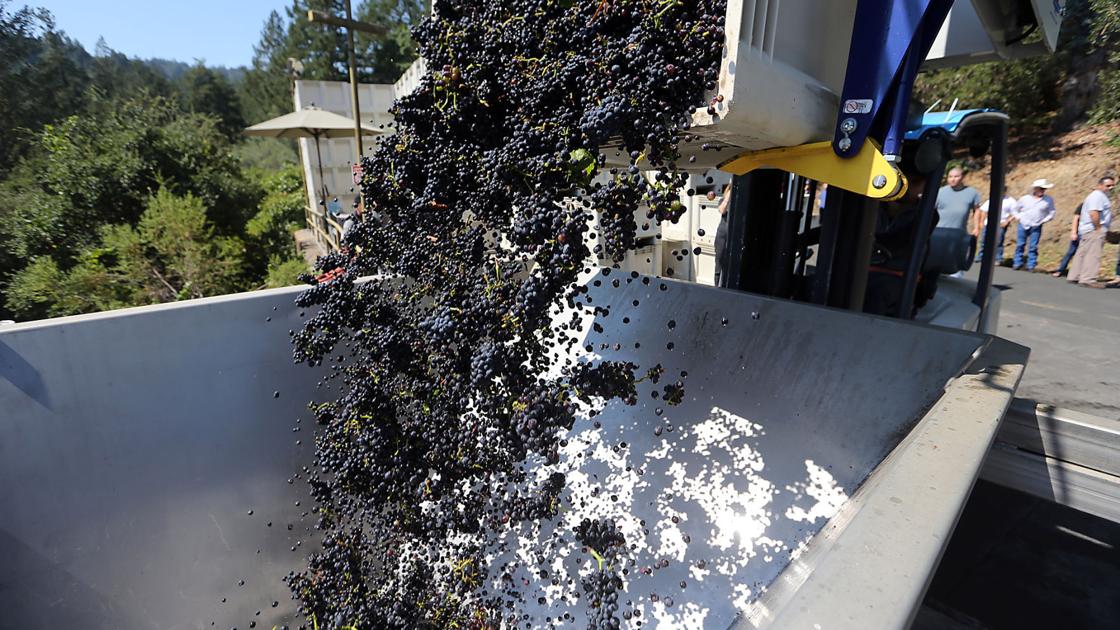

Schramsberg Pinot Noir grapes go into the crusher at the onset of harvest 2017. This year's preliminary grape crush report from Ciatti Company, a bulk wine and grape broker, shows Napa Valley's 2020 crush down almost 40%.
Napa County’s wine industry crushed just under 100,000 tons of grapes in 2020, according to a preliminary crush report from the California Department of Food and Agriculture, marking an almost 40% decline year over year.
Harvested wine grapes are crushed to be made into wine, making “tons crushed” an apt metric for forecasting the size of any given vintage. In 2020, wine producers statewide crushed an average of 13.9% less than in 2019, data from the report shows — a decline that can be attributed in part to the year’s crop yield, which growers said even early into the growing season would be naturally lighter.
The decline in tons crushed in Napa Valley, though, cannot be attributed in its entirety to normal deviations in crop size, according to Glenn Proctor, partner at the bulk grape and wine brokerage firm Ciatti Company. Tonnage out of Napa County was down by 38.5%; by comparison, the Central Valley, whose grape growers emerged comparatively unscathed from 2020’s fire season, were down anywhere from 10 to 15%, Proctor explained.
We're offering our best deal ever with this Editor's Special. Support local news coverage by subscribing to the Napa Valley Register.
In Napa, the drop is in large part due to the year’s devastating wildfire season, during which not just one but two catastrophic fires sent smoke to hang over much of Napa Valley, including its vineyards.
“The North Coast is where the purchase of grapes was really affected by smoke concerns,” Proctor said, citing Napa County and Sonoma County, where production was down 36%.
Buyers sometimes balk at purchasing wine grapes that have been exposed to wildfire smoke over concern of smoke taint, a phenomenon in which wine grapes absorb certain smoky compounds, essentially rendering them unusable for wine production.
In 2020, smoke taint was especially widespread — partially because the year’s first wildfire, the Hennessey Fire, began in August, unusually early in the growing season. In some cases, smoke prompted contract renegotiations between growers and vintners; other growers, knowing their fruit had received catastrophic levels of smoke exposure, chose not to pick or sell their fruit, and instead made claims on their crop insurance policies.
Napa Valley’s red wine grape varieties appear most impacted by the wildfires, according to Proctor. In Napa Valley, the report shows, tons crushed of Cabernet Sauvignon — the region’s flagship grape — were down 42%. (Merlot and Zinfandel were also down 42% and 47% respectively.)
Adding to industry pressure is an existing grape glut — an oversupply of grapes coupled with a slight drop in consumer wine demand in 2019 — that has hung over California’s wine industry for the last year.
The oversupply began to depress wine grape prices, and wineries even in the North Bay began to seek their exits from long-term grape growing contracts, which often included annual increases on the price to be paid per ton of grapes. (Industry members previously said those types of contracts were artificially inflating the price per ton paid in premium growing regions like Napa Valley.)
In 2020, the average price per ton of wine grapes in Napa County declined 21%, the report shows. It’s hard to say how much of the drop was prompted by contract attrition and how much could be attributed to renegotiations in the wake of concerns over smoke, Proctor said. Either way, one thing is clear: growers “took a hit” this year.
“The tough thing (about this harvest) from a grower point of view is that there were fewer tons per acre crushed, and the tons that were crushed were purchased for a lower price,” Proctor said, citing the wildfires as the cause for the trend. “Usually, you’d see lower tons and higher prices.”
It’s unclear where the market for Napa Valley grapes and wine will go from here, Proctor added: 2020’s short harvest did technically correct the oversupply of grapes, but the pandemic may continue to adversely impact consumer demand for wine. If that drop in demand continues, a large or even regular-sized harvest in 2021 could set the industry back into a glut.
WATCH NOW: HARVEST 2020 AT SCHRAMSBERG
IMAGES AS THE GLASS FIRE RACED ACROSS NAPA VALLEY
California Wildfires

Cellar worker Jose Juan Perez sprays water on burning debris at Castello di Amorosa, Monday, Sept. 28, 2020, in Calistoga, which was damaged in the Glass Fire.
California Wildfires

Cellar worker Jose Juan Perez extinguishes hotspots at a Castello di Amorosa outbuilding, Monday, Sept. 28, 2020, in Calistoga, Calif., which was damaged in the Glass Fire. (AP Photo/Noah Berger)
California Wildfires
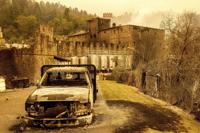
A damaged vehicle and wine warehouse stand, Monday, Sept. 28, 2020, in Calistoga at Castello di Amorosa, which was damaged in the Glass Fire.
California Wildfires

Georg Salzner, president and CEO of Castello di Amorosa, sprays water, Monday, Sept. 28, 2020, in Calistoga, Calif., on a building which was damaged in the Glass Fire. (AP Photo/Noah Berger)
California Wildfires

Winery workers Carlos Perez, left, and Jose Juan Perez extinguish hotspots at Castello di Amorosa, Monday, Sept. 28, 2020, in Calistoga, Calif., which was damaged in the Glass Fire. (AP Photo/Noah Berger)
California Wildfires

Georg Salzner, president and CEO of Castello di Amorosa, sprays water on a building, Monday, Sept. 28, 2020, in Calistoga, Calif., which was damaged in the Glass Fire. (AP Photo/Noah Berger)
California Wildfires
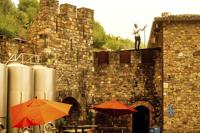
Georg Salzner, president and CEO of Castello di Amorosa, sprays water on a building at the property, Monday, Sept. 28, 2020, in Calistoga, Calif., which was damaged in the Glass Fire. (AP Photo/Noah Berger)
California Wildfires

Charred wine bottles rest at Castello di Amorosa, Monday, Sept. 28, 2020, in Calistoga, Calif., which was damaged in the Glass Fire. (AP Photo/Noah Berger)
California Wildfires

Charred wine bottles rest at Castello di Amorosa, Monday, Sept. 28, 2020, in Calistoga, which was damaged in the Glass Fire.
California Wildfires

Charred wine bottles rest at Castello di Amorosa, Monday, Sept. 28, 2020, in Calistoga, Calif., which was damaged in the Glass Fire. (AP Photo/Noah Berger)
California Wildfires
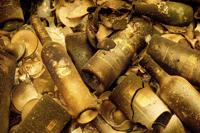
Charred wine bottles rest at Castello di Amorosa, Monday, Sept. 28, 2020, in Calistoga, Calif., which was damaged in the Glass Fire. (AP Photo/Noah Berger)
California Wildfires

Charred wine bottles rest at Castello di Amorosa, Monday, Sept. 28, 2020, in Calistoga, Calif., which was damaged in the Glass Fire. (AP Photo/Noah Berger)
California Wildfires

Winery worker Carlos Perez, left, walks, Monday, Sept. 28, 2020, in Calistoga, Calif., through Castello di Amorosa, which was damaged in the Glass Fire. Perez helped build the wine cellar that was scorched in the blaze. (AP Photo/Noah Berger)
California Wildfires

A chimney stands, Monday, Sept. 28, 2020, at the Restaurant at Meadowood, which burned in the Glass Fire, in St. Helena, Calif. (AP Photo/Noah Berger)
California Wildfires

A staircase remains, Monday, Sept. 28, 2020, at the Restaurant at Meadowood, which burned in the Glass Fire, in St. Helena.
California Wildfires

A staircase stands, Monday, Sept. 28, 2020, at the Restaurant at Meadowood, which burned in the Glass Fire, in St. Helena. (AP Photo/Noah Berger)
California Wildfires
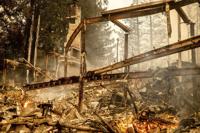
Charred framing remains, Monday, Sept. 28, 2020, at the Restaurant at Meadowood, which burned in the Glass Fire, in St. Helena.
California Wildfires
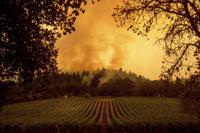
Smoke rises over a vineyard as the Glass Fire burns, Monday, Sept. 28, 2020, in Calistoga.
California Wildfires
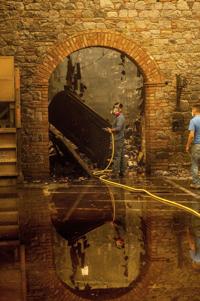
Cellar worker Jose Juan Perez extinguishes hotspots at Castello di Amorosa, which was damaged in the Glass Fire, Monday, Sept. 28, 2020, in Calistoga, Calif. (AP Photo/Noah Berger)
Napa's Burning Problem: A Napa Valley Register series taking an in-depth look at Napa County's vulnerability to wildfires
The Napa Valley Register takes an in-depth look at Napa County's vulnerability to wildfires in this four-part series.
Napa County is looking for ways to make the recent megafires a memory, not a harbinger.
The prospect of major wildfires each fall is a terrifying prospect for Napa Valley's wine industry.
Intense wildfire is no longer just a rural problem, worried city officials say.
Napa County is seeking ways to keep the 2021 fire season from being a repeat of 2020 and 2017.
You can reach Sarah Klearman at (707) 256-2213 or sklearman@napanews.com.
February 11, 2021 at 06:30AM
https://ift.tt/3a7vz69
Preliminary grape crush report reveals Napa Valley production down almost 40% - Napa Valley Register
https://ift.tt/3eO3jWb
Grape

No comments:
Post a Comment